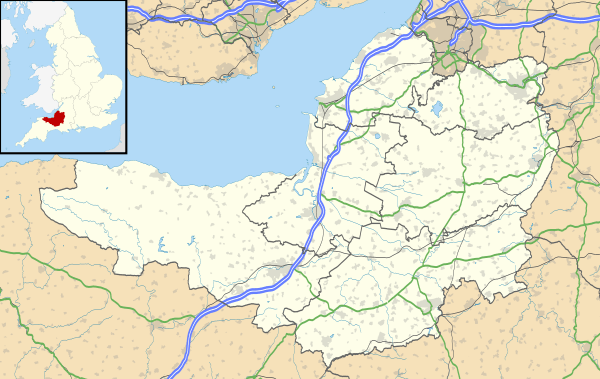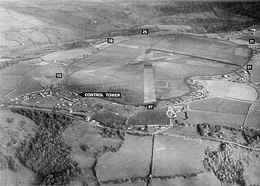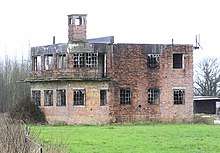RAF Charmy Down
RAF Charmy Down is a former Royal Air Force (RAF) station in Somerset, England. The airfield is located approximately 3 miles (4.8 km) north-northeast of Bath; about 96 miles (154 km) west of London
RAF Charmy Down USAAF Station AAF-487  | |||||||||||||||||||
|---|---|---|---|---|---|---|---|---|---|---|---|---|---|---|---|---|---|---|---|
 Aerial photograph of RAF Charmy Down looking north, the control tower and technical site is on the left, 4 December 1943. | |||||||||||||||||||
| Summary | |||||||||||||||||||
| Airport type | Military | ||||||||||||||||||
| Owner | Air Ministry | ||||||||||||||||||
| Operator | Royal Air Force United States Army Air Forces | ||||||||||||||||||
| Location | North of Swainswick, Somerset | ||||||||||||||||||
| Built | 1941 | ||||||||||||||||||
| In use | 1941-1946 | ||||||||||||||||||
| Elevation AMSL | 669 ft / 204 m | ||||||||||||||||||
| Coordinates | 51°25′46″N 002°20′50″W | ||||||||||||||||||
| Map | |||||||||||||||||||
 RAF Charmy Down Location in Somerset | |||||||||||||||||||
| Runways | |||||||||||||||||||
| |||||||||||||||||||
Opened in 1941 it was used initially by the RAF and then later by the United States Army Air Forces. During the war it was used primarily as night fighter interceptor airfield. After the war it was closed in 1945.
Today the remains of the airfield are located on private property and are used as agricultural fields.[1]
History
Built on a kerbed Long barrow site, where a cremation urn was found, near a burial of a long necked beaker, and a bronze dagger, these are believed to be from the Beaker people.[2] The kerbed Long Barrows were then flattened to make way for the airfield.
It was originally planned as a satellite for the Maintenance Unit at nearby RAF Colerne but by the time construction work started in 1940 it had been selected as a sector station by No. 10 Group of RAF Fighter Command.[3]
RAF Charmy Down was opened late in 1940 and originally had a grass surface with landing strips of 4,125 feet (1,257 m), both south east to north west and north east to south west. It was later upgraded to the Class A airfield standard set by the British Air Ministry in 1941, the main feature of which was a set of three converging runways each containing a concrete runway for takeoffs and landings, optimally placed at 60-degree angles to each other in a triangular pattern. In addition a 50 feet (15 m) wide tarmac perimeter track and 39 aircraft dispersal points was constructed. These were 12 double pens and 15 single standings.[3]
The technical site was connected to the ground station and airfield consisted of 12 Blister hangars and one Bellman hangar and various organisational, component and field maintenance shops along with the maintenance personnel necessary to keep the aircraft airworthy and to quickly repair light and moderate battle damage.[4] Depot personnel performed depot-level maintenance on aircraft as well as performing major structural repair on severely damaged combat aircraft. The Ammunition dump was located on the north side of the airfield, outside the perimeter track surrounded by large dirt mounds and concrete storage pens for storing the ammunition required by the aircraft.
Royal Air Force use

The first occupant of Charmy Down was No. 87 Squadron RAF, with night-fighting Hawker Hurricanes, In the summer of 1941 Boulton Paul Defiants appeared and Westland Whirlwinds and Turbinlite Havocs of 125 and 263 squadrons respectively were to be seen the following year. 137 Squadron replaced No 263 Squadron in September 1941. In November 1941 417 Squadron of the Royal Canadian Air Force was formed here.[3]

During 1942 various other squadrons were posted to Charmy Down including 533 Squadron which was formed on 8 September 1942,[5] from No. 1454 (Turbinlite) Flight,[6][7] as part of No. 10 Group RAF in Fighter Command. Instead of operating only Turbinlite and Airborne Intercept (AI) radar equipped aircraft (Havocs and Bostons) and working together with a normal nightfighter unit, such as the Hawker Hurricanes of 87 Squadron,[6] the unit also flew with their own Hurricanes. It was disbanded at Charmy Down on 25 January 1943,[5] when Turbinlite squadrons were, due to lack of success on their part and the rapid development of AI radar, thought to be superfluous.[8]
A Supermarine Spitfire Operational Training Unit took over in 1943 and stayed until the airfield was turned over to the USAAF in November 1943.[3]
United States Army Air Forces use

Charmy Down was known as USAAF Station AAF 487 for security reasons by the USAAF during the war, and by which it was referred to instead of location.[9] The airfield code/USAAF Station Code was "CH".
4th Tactical Air Depot
Service groups were deployed there late in 1943 to operate the 4th Tactical Air Depot, which was intended to repair, modify and maintain Allison-engined fighter types, primarily Lockheed P-38 Lightnings and North American P-51 Mustangs.
For unrecorded reasons, it was decided to transfer this operation to Kingston Bagpuize early in 1944, possibly for better local logistics and communications in the Oxford area. Nevertheless, IX Air Force Service Command activities continued at Charmy Down until the autumn of 1944.[10]
422d, 423d and 425th Night Fighter Squadrons
The Ninth Air Force was scheduled to receive three night fighter squadrons with a mission to effect night air defence of US airfields when these were established on the Continent. RAF Charmy Down was selected as an airfield for these squadrons which would arrive individually, not as part of a group, and were to be equipped with the new Northrop P-61 Black Widow.[11]
Personnel of the 422nd Night Fighter Squadron arrived first on 7 March 1944 and had their aircrews posted to various RAF night fighter and signal schools for theatre indoctrination.
Postwar use
After the end of hostilities in Europe, the airfield returned to the RAF. There was little flying from the station although it was not officially closed until October 1946. From the January 1946 to October 1946, No 92 Gliding School, Air Training Corps used the airfield and it was home to the Personnel Resettlement Centre for Australians.[3]
In the 1950s, Charmy Down was included as a low priority on the list of sites for the deployment of the ROTOR radar system. Construction started in May 1953 but was abandoned in April 1955, and only ground works now remain.[12]
Current use

With the facility released from military control, the airfield stood intact yet disused for many years.[3] Eventually the hangars were removed, but the outline of the runways can still be seen in aerial photography and test probing (2018) suggests the runways remain approximately 5 cm below the now grassed over tarmac. Most of the perimeter track still remains mostly in a half-width condition, as do several of the derelict buildings, including the control tower,[13] a few of the Blister hangars still remain and are used for farm storage. Most of the pillboxes also remain but, being largely subterranean, are filled in. The ammunition dumps, also derelict, remain.
Bath and North East Somerset Council has considered, but rejected, the option of building a Park and Ride for Bath on Charmy Down.[14][1]
Part of the 06/24 runway serves as a microlight airstrip (2018), and model aircraft are flown further along (NNE) the same runway.
A large part of the old RAF Charmy Down airfield, and some adjacent land, is currently owned by Wessex Water who own Monkswood Reservoir, built in 1896, situated 1 kilometre (0.62 mi) north of the airfield.[15]
References
![]()
Citations
- Site Options: High Level - Bath Eastern Park and Ride Sites (PDF). Halcrow (Report). Bath and North East Somerset Council. 9 May 2013. pp. 17–20, 48. Retrieved 20 July 2020.
The site currently comprises open, level agricultural farmland with a large-scale, angular field pattern enclosed by scrubby hedgerows, wire fencing and occasional dry stone walls. ... The site is Grade 3 agricultural land
- "The Beaker people and the Bronze Age". Somerset County Council. Retrieved 22 January 2011.
- Berryman, David (2006). Somerset airfields in the Second World War. Newbury: Countryside Books. pp. 34–49. ISBN 1-85306-864-0.
- "Charmy Down Airfield 2008". Aviation Addicts. Retrieved 20 January 2013.
- Jefford 1988, p. 97.
- Rawlings, John D.R. Fighter Squadrons of the RAF and their Aircraft. London: Macdonald & Jane's (Publishers) Ltd., 1969 (2nd edition 1976, reprinted 1978). ISBN 0-354-01028-X. page 465
- Sturtivant 2007, p. 123.
- Halley 1988, p. 402.
- "United States Army Air Force Station Numbers". GI trace. Retrieved 20 January 2013.
- Wakefield, Ken (1994). Operation Bolero: The Americans in Bristol and the West Country 1942-45. Crecy Books. p. 62. ISBN 0-947554-51-3.
- Bishop, Chris (2002). The Encyclopedia of Weapons of WWII: The Comprehensive Guide to Over 1,500 Weapons Systems, Including Tanks, Small Arms, Warplanes, Artillery, Ships,. MetroBooks. p. 358. ISBN 978-1586637620.
- McCamley, Nick (2013). Cold War Secret Nuclear Bunkers: The Passive Defence of the Western World During the Cold War. Pen and Sword. p. 100. ISBN 9781844155088. Retrieved 22 April 2019.
- "Charmy Down". Control Towers UK. Retrieved 22 January 2011.
- "Guildhall protest over Bathampton park and ride plan". Bath Chronicle. 8 November 2008. Retrieved 25 January 2011.
- "Reservoir Safety and the Environment: Proceedings of the Eighth Conference of the British Dam Society Held at the University of Exeter, 14-17 September 1994". Thomas Telford. 1994. pp. 74–79. Retrieved 20 July 2020.
Bibliography
| Wikimedia Commons has media related to RAF Charmy Down. |
- Freeman, Roger A. (1994) UK Airfields of the Ninth: Then and Now. After the Battle ISBN 0-900913-80-0
- Halley, James J. The Squadrons of the Royal Air Force & Commonwealth, 1981-1988. Tonbridge, Kent, UK: Air-Britain (Historians) Ltd., 1988. ISBN 0-85130-164-9.
- Jefford, C.G. RAF Squadrons, a Comprehensive Record of the Movement and Equipment of all RAF Squadrons and their Antecedents since 1912. Shrewsbury, Shropshire, UK: Airlife Publishing, 1988. ISBN 1-84037-141-2.
- Maurer, Maurer (1983). Air Force Combat Units of World War II. Maxwell AFB, Alabama: Office of Air Force History. ISBN 0-89201-092-4.
- Sturtivant, R. RAF Flying Training and Support Units since 1912. Air Britain, 2007. ISBN 0-85130-365-X.

.svg.png)